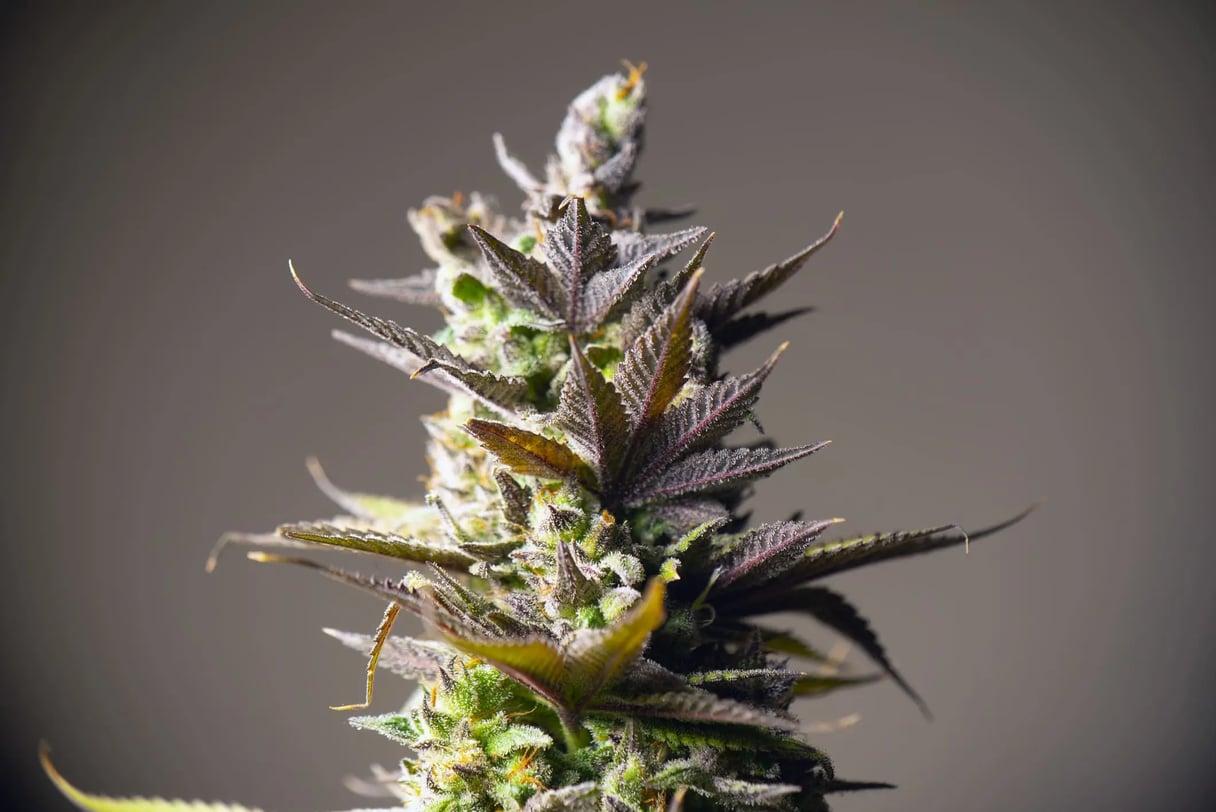Introduction
Exploring the Enigmatic World of Terpineol: A Journey into a Lesser-Known Terpene
In the vast, intricate world of cannabis strains and their constituents, terpineol emerges as a subtly influential component. This terpene alcohol, found in over 150 plants, including cannabis, is a blend of four isomers, with α-terpineol being the most prevalent. Known for its pleasant citrusy aroma, interlaced with herbaceous undertones, terpineol distinguishes itself through its scent, evoking images of lilacs and fresh flowers. This aromatic profile not only enhances the sensory experience of cannabis connoisseurs but also plays a pivotal role in the plant’s interaction with its environment.
The presence of terpineol in cannabis is not just about adding to the plant’s aromatic complexity; it’s an integral part of the plant’s biological tapestry. As a terpene alcohol, terpineol shares the basic chemical structure of terpenes, contributing to the unique characteristics of different cannabis strains. This versatility in aroma and effect underscores the importance of terpineol in the overall perception and efficacy of cannabis products, making it a key player in the plant’s multifaceted profile.
Introducing Terpineol: A Hidden Gem in the Terpene Family
Terpineol, while less renowned than some of its terpene counterparts, is an unsung hero in the cannabis world. Its importance is highlighted not only by its presence in cannabis but also by its widespread occurrence in nature, from lilac trees to eucalyptus sap. Terpineol’s therapeutic potential ranges from anti-inflammatory to antimicrobial properties, marking it as a terpene with significant benefits beyond its sensory appeal.
In addition to its natural abundance, terpineol’s role in the cannabis plant is multifaceted. It contributes to the entourage effect, where terpenes work synergistically with cannabinoids to enhance the plant’s therapeutic properties. This interaction illustrates terpineol’s ability to modulate the effects of cannabis, playing a crucial role in the plant’s impact on users. Its presence in various cannabis strains influences the overall experience, from the scent to the physiological effects, making terpineol a valuable component in the cannabis industry.

Discovering Terpineol: A Subtle Yet Influential Terpene
The Basics of Terpineol: Scientific Understanding and Structure
Terpineol, a monoterpenoid, is a fascinating compound found in the essential oils of numerous plants, including cannabis. Its chemical formula, C10H18O, reflects a simple yet versatile structure. Terpineol typically presents as a colourless liquid, boasting a boiling point of 214–217°C and a melting point ranging from −35.9 to −28.2°C. This physical profile contributes to its widespread use in various industries. In cannabis, terpineol plays a crucial role, contributing not only to the plant’s aromatic profile but also potentially influencing its therapeutic effects.
Understanding the chemistry of terpineol is vital for appreciating its role in cannabis and other plants. Its solubility in water and its mild sedative effects, as indicated in cannabis use, showcase its potential as a multifunctional compound. This terpene alcohol demonstrates the complex interplay between cannabis’s chemical components and its overall impact on users, highlighting the need for continued research into its specific actions and benefits within the cannabis plant.
Chemical Nature and Variants of Terpineol: α-Terpineol, β-Terpineol, and Others
Terpineol comprises four isomeric forms: α-terpineol, β-terpineol, γ-terpineol, and 4-terpineol, with α-terpineol being the most common. These isomers, although similar in structure, exhibit subtle differences in their properties and effects. α-Terpineol, particularly noted for its pleasant, lilac-like aroma, is a significant component in various fragrant plants and is extensively used in the perfume and hygiene product industries.
The variants of terpineol, each with its unique characteristics, contribute to the compound’s versatility. From its role in flavouring food products to its presence in soaps and lotions, α-terpineol’s applications are diverse. Its importance in the cannabis industry cannot be overstated, as it adds to the complexity and therapeutic potential of cannabis-derived products. This diversity in application highlights terpineol’s significance beyond its mere chemical structure, positioning it as a terpene of great interest in both scientific and commercial domains.
The Unseen Presence: Terpineol in Everyday Plants and Aromas
Terpineol’s presence is not limited to the laboratory or specialised industries; it is an integral part of our daily sensory experiences. In plants like saffron, green tea, lilac trees, clary sage, lemon, star anise, and eucalyptus, terpineol contributes to the unique aromas and flavours we encounter regularly. Its lilac aroma, especially in α-terpineol, is a familiar and comforting scent in many households, often used in hygiene products and cleaners.
In the realm of cannabis, terpineol adds to the plant’s complex aromatic profile, influencing the overall sensory experience of different strains. This terpene’s ability to blend seamlessly into our everyday lives while playing a pivotal role in the nuances of cannabis aroma and flavour underscores its importance in natural and human-made environments. The widespread use of terpineol in products ranging from food to cosmetics speaks to its versatility and the discreet yet significant impact it has on our daily experiences.
Terpineol’s Historical Use and Cultural Significance
Ancient Roots: Terpineol in Traditional Medicine and Culture
Terpineol has a rich history in traditional medicine, having been used for centuries in various cultures for its healing properties. For instance, lime blossom, containing high levels of terpineol, was a staple in European traditional medicine for treating coughs, colds, and flu. This historical use underlines terpineol’s significance beyond its aromatic appeal, highlighting its role as a natural remedy. The “nectar of kings” aroma, as it’s affectionately called, points to its esteemed place in cultural practices and traditional healing methods.
The utilisation of terpineol in traditional medicine reflects a deep understanding of the natural world and its resources. From brewing teas to concocting herbal remedies, different cultures have harnessed the benefits of terpineol, illustrating the compound’s versatility and efficacy. This historical perspective enriches our understanding of terpineol and inspires contemporary research into its potential applications and benefits.
Cross-Cultural Echoes: Terpineol in Historical Context
Terpineol’s historical significance transcends geographical boundaries, marking its presence in various cultural contexts. The compound’s versatility is evident in its use across different cultures, from European traditional medicine to Asian herbal practices. Its wide-reaching influence is a testament to the universal recognition of its beneficial properties.
The cross-cultural utilisation of terpineol in various forms, whether in medicinal teas or aromatic oils, reflects a shared human experience of seeking natural solutions for health and well-being. This historical tapestry of terpineol usage underscores the importance of preserving traditional knowledge and exploring its relevance in modern-day applications.
Terpineol and Its Siblings: Comparative Analysis
Unique Yet Connected: Comparing Terpineol with Other Terpenes
While unique in its properties, Terpineol shares similarities and differences with other terpenes, such as terpinolene. Terpineol is known for its sweet, floral scent reminiscent of lilacs, whereas terpinolene exhibits a fresh, woody, floral aroma, often associated with pine. Understanding these distinctions is crucial in appreciating terpineol’s unique contribution to the aromatic profiles of plants, especially cannabis.
The comparison with terpinolene highlights terpineol’s uniqueness in the terpene family. While both contribute to the calming and soothing effects of cannabis, their distinct aromas and vaporisation temperatures (terpineol is lower at approximately 338°F) differentiate their roles and effects.
Chemical Cousins: Similarities and Differences with Pinene and Limonene
Compared to other terpenes like pinene and limonene, terpineol shares certain chemical characteristics but differs significantly in others. Pinene, known for its pine-like scent, and limonene, with its citrusy aroma, contrast with terpineol’s sweeter, floral notes. However, all three contribute to the entourage effect in cannabis, enhancing the plant’s therapeutic properties.
The chemical nuances among these terpenes underscore the complexity of cannabis’s aromatic and therapeutic profile. Understanding these subtleties is key to comprehending the full spectrum of cannabis’s potential benefits, with terpineol playing a significant role alongside its terpene counterparts.

Deep Dive into Terpineol’s Chemistry
The Science of Terpineol: Detailed Chemical Properties
Terpineol, with its chemical formula C10H18O, is a testament to the intricate nature of organic compounds. This monoterpenoid, typically a colourless liquid, has a melting point of −35.9 to −28.2°C and a boiling point of 214–217°C. These properties hint at its stability and volatility, important factors in its application across various industries. The solubility of terpineol in water, 2.42 g/L, also plays a crucial role in its usage, particularly in products that must be dissolved or diluted.
Understanding terpineol’s chemical properties is crucial in unravelling its interactions in different environments, whether in the human body, in plants, or in manufactured products. Its mild sedative effects in cannabis use, for example, are a direct result of its unique chemical structure, influencing its efficacy and application in wellness and therapeutic areas.
Interactions and Reactions: Terpineol in the Chemical World
Terpineol’s interactions and reactions within the chemical world are diverse. As a terpene alcohol, it participates in various chemical reactions, contributing to its wide range of applications. Its ability to bind with other organic compounds, enhance fragrances, and contribute to flavour profiles makes it a valuable ingredient in the perfume and food industries.
In the context of cannabis, terpineol’s interaction with cannabinoids and other terpenes is of particular interest. Its role in the entourage effect, where it potentially modulates and enhances the effects of cannabinoids, highlights the importance of understanding its chemical interactions for optimising cannabis-based products.
Terpineol’s Role in Ecology and Sustainability
Harvesting Harmony: Environmental Impact of Terpineol Sourcing
The sourcing of terpineol, primarily from plants like saffron, green tea, lilac trees, and eucalyptus, raises important questions about its environmental impact. The sustainability of extracting terpineol from these natural sources is crucial, as it involves balancing the demand for this compound with the preservation of ecosystems. Responsible sourcing practices are essential to ensure that the extraction of terpineol does not lead to ecological imbalances or the depletion of natural resources.
The use of terpineol in everyday products, such as hygiene items and cleaners, necessitates an environmentally conscious approach to its production. This includes considering the lifecycle of these products and the eventual disposal of terpineol-containing materials, ensuring minimal environmental footprint.
Green Chemistry: Sustainable Practices in Terpineol Production
The concept of green chemistry is pivotal in the production of terpineol. Sustainable practices involve minimising waste, reducing energy consumption, and using renewable resources wherever possible. Adopting green chemistry principles in terpineol production benefits the environment and enhances the safety and efficiency of the processes involved.
Innovations in the extraction and synthesis of terpineol can lead to more environmentally friendly methods, reducing the reliance on chemical solvents and intensive energy processes. This approach aligns with the growing demand for sustainable and eco-friendly products, particularly in industries like cosmetics and food production, where terpineol is extensively used.
Industrial and Commercial Uses of Terpineol
Beyond Aromatics: Terpineol in Various Industries
Terpineol’s applications extend far beyond its aromatic properties. Its presence in hygiene products like soaps and lotions is well-known, attributed to its pleasant fragrance and skin-friendly nature. Additionally, its use in household cleaners highlights its versatility and effectiveness as an ingredient in consumer products. In the food industry, terpineol is used to flavour various products, enhancing their taste profiles.
The versatility of terpineol in different industries showcases its functional properties, making it a compound of choice for various applications. Its ability to blend seamlessly into products that are part of daily life underlines its significance in the commercial sector.
Economic Impact: Terpineol in Commercial Applications
The economic impact of terpineol in commercial applications is significant. As a compound that enhances the sensory appeal of products, it plays a vital role in marketability and consumer preference. The demand for terpineol in perfumery, cosmetics, and food processing speaks to its commercial value and the economic opportunities it presents.
The production and distribution of terpineol also contribute to economic growth, providing employment opportunities and driving innovation in extraction and synthesis techniques. Its wide-ranging applications ensure a steady market demand, underlining its importance as a chemical compound and a driver of economic activity.

Safety and Regulatory Aspects of Terpineol
Navigating Safety: Understanding Terpineol’s Side Effects and Contraindications
Terpineol is generally considered safe for human consumption and topical use. However, like any compound, it may have side effects and contraindications. Its mild sedative effects suggest users should be cautious when higher energy levels are required. For topical use, although generally safe, some users may experience skin irritation or allergic responses, highlighting the importance of patch-testing products before widespread use.
Legal Landscape: Terpineol’s Regulatory Status Worldwide
The regulatory status of terpineol varies worldwide, influenced by its diverse applications in food, cosmetics, and healthcare products. Understanding these regulations is crucial for manufacturers and consumers alike to ensure compliance and safety in using and distributing terpineol-containing products.
Terpineol’s Natural Habitat and Aroma Profile
Unearthing Terpineol’s Presence: From Pine Trees to Eucalyptus
Terpineol, a versatile terpene, is prevalent in many plants, such as pine trees, lilacs, and eucalyptus. Its role transcends mere aroma enhancement and is pivotal in maintaining ecological balance. The distinct scents of these plants, enriched by terpineol, are appealing to the human senses and crucial to an intricate web. They facilitate vital interactions between plants and pollinators, thereby supporting biodiversity. Moreover, terpineol contributes to plants’ defensive mechanisms, deterring pests and herbivores. This multifaceted role of terpineol in the natural world underscores its significance beyond just a sensory delight, highlighting its contribution to the health and resilience of ecosystems.
Aromatic Characteristics: The Subtle Nuances of Terpineol’s Scent
Terpineol’s scent, a delicate blend of sweet and floral notes reminiscent of lilacs, is a cornerstone of its allure. This fragrance is not merely pleasant; it’s a nuanced symphony that adds depth and complexity to many scents. In perfumery and aromatherapy, terpineol is prized for its ability to infuse products with an understated yet memorable aroma. Its versatility allows it to blend seamlessly with other scents, enhancing and rounding out the overall olfactory experience. This capability makes it a valuable component in scent creation, contributing to fragrance design’s intricacies and aroma therapy’s art.
The Invisible Touch: How Terpineol Shapes Our Sensory Experiences
Terpineol’s influence on our daily sensory experiences is both profound and subtle. It imbues everyday products like soaps, lotions, and teas with pleasant aromas, often enhancing our routine activities without conscious recognition. This unobtrusive presence enriches our day-to-day lives, elevating mundane moments with an added layer of sensory pleasure. In this way, terpineol plays a key role in shaping our perception of well-being, contributing to an atmosphere of comfort and relaxation. Its ability to blend into various products while significantly impacting our sensory experiences showcases the power of aroma in creating a soothing and pleasant environment.
Terpineol in Essential Oils and Aromatherapy
The Role of Terpineol in Essential Oil Therapies
Terpineol’s integration into essential oil therapies is a testament to its therapeutic prowess. In these treatments, it’s not merely a passive ingredient but actively contributes to the therapeutic effects. Essential oils containing terpineol are often used for their calming and soothing properties, making them ideal for relaxation and stress relief. Their application in aromatherapy taps into terpineol’s ability to positively influence mood and mental well-being. This role in essential oil therapies highlights the compound’s significance in natural wellness and its potential in alternative healing practices.
Soothing Scents: Terpineol’s Contribution to Aromatherapy
In aromatherapy, terpineol is celebrated for its gentle, soothing scent. This terpene enhances the aromatic experience, lending its unique floral and sweet notes to various blends. Its presence in aromatherapy oils is thought to aid in relaxation, reduce anxiety, and promote a sense of tranquillity. Terpineol’s contribution extends beyond mere olfactory pleasure; it is believed to profoundly affect the mind and body, providing a natural way to ease stress and improve overall well-being. Its aromatherapy efficacy underscores natural scents’ power in holistic health practices.
Harnessing Terpineol: Potential Benefits in Holistic Practices
Terpineol’s potential benefits in holistic practices are diverse and promising. It is increasingly being recognised for its ability to enhance the therapeutic properties of essential oils and salves. In holistic medicine, terpineol-infused products are used for their potential anti-inflammatory and antimicrobial properties, offering a natural alternative for managing various health concerns. This terpene’s incorporation into holistic practices reflects a growing interest in harnessing natural compounds for health and wellness, highlighting terpineol’s potential as a key player in the future of natural therapies.

Health Benefits and Therapeutic Potential of Terpineol
Exploring Terpineol’s Medicinal Properties
Terpineol, prevalent in many plants, including cannabis, is gaining attention for its medicinal properties. Research delves into its potential therapeutic benefits, exploring how it interacts with biological systems. Its presence in traditional remedies underscores a historical belief in its healing powers, a belief now being scrutinised through modern scientific methods. Studies are increasingly focusing on how terpineol can contribute to health and wellness, examining its effects on various physiological processes. This exploration is about understanding Terpineol’s capabilities and integrating it into contemporary medical practices, potentially offering new avenues for treatment and wellness.
Potential Anti-inflammatory and Antimicrobial Effects of Terpineol
The potential anti-inflammatory and antimicrobial effects of terpineol are at the forefront of current research. These properties position terpineol as a candidate for developing natural therapies for conditions characterised by inflammation and bacterial infections. Its antimicrobial efficacy suggests possible applications in treating infections without the resistance issues commonly associated with synthetic antibiotics. Similarly, its anti-inflammatory potential could make it valuable in managing chronic inflammatory conditions. This research expands our understanding of terpineol’s pharmacological profile and contributes to the broader field of natural product research, highlighting the relevance of plant-derived compounds in modern medicine.
Relaxation and Sedation: Terpineol’s Calming Influence
The calming influence of terpineol particularly noted in aromatherapy, positions it as a natural alternative for managing stress and anxiety. Its soothing properties are being explored for their potential to aid in sleep disorders and general relaxation. Unlike synthetic sedatives, terpineol offers a gentler approach, potentially reducing the risk of side effects and dependency. Exploring these properties is not just about finding new uses for terpineol but also about understanding how natural compounds can complement or replace traditional pharmacological treatments. This research is particularly relevant to the growing interest in holistic and integrative health approaches.
Terpineol in Modern Research and Future Prospects
Current Studies and Scientific Research on Terpineol
Current research on terpineol is focused on unlocking its full potential across various medical and therapeutic fields, UK medical cannabis included. Scientists are investigating its pharmacokinetics, efficacy, and safety, aiming to translate traditional knowledge into scientifically validated applications. This research spans from in vitro studies to clinical trials, seeking to understand the breadth and depth of terpineol’s therapeutic capabilities. As a natural compound with a relatively low side-effect profile, terpineol is becoming increasingly attractive to researchers looking for safer, more sustainable medical interventions.
Pioneering Investigations: Terpineol’s Emerging Therapeutic Uses
Pioneering investigations into terpineol are uncovering its emerging therapeutic uses. Researchers are exploring its potential in treating chronic pain, reducing anxiety, and even combating certain types of cancer. These studies are crucial for developing new, natural-based therapies, potentially revolutionising how certain conditions are treated. The exploration of terpineol’s therapeutic applications is also prompting a re-evaluation of the role of natural compounds in modern medicine, underscoring the importance of biodiversity and natural resource conservation in pharmaceutical development.
Uncharted Frontiers: Future Directions in Terpineol Research
The future of terpineol research lies in exploring its uncharted potential. Scientists are probing into how it interacts at the molecular level, its long-term effects, and its potential as a complementary therapy alongside conventional treatments. The prospect of terpineol in pharmaceuticals is particularly exciting, offering the possibility of more natural, less invasive treatment options. This research is about discovering new therapeutic uses and understanding the broader implications of integrating natural compounds into the healthcare system, challenging and expanding our current medical treatment paradigms.
Terpineol’s Broad Reach: From Nature to Science
A Journey through Terpineol’s Diverse Roles in Nature and Health
Terpineol’s journey from a component in nature to a subject of scientific intrigue is remarkable. In nature, it plays multiple roles, from contributing to the aromatic allure of plants to participating in their defence mechanisms. In health, terpineol is being explored for its therapeutic potential, ranging from its calming effects in aromatherapy to its possible anti-inflammatory and antimicrobial properties. This journey reflects the intricate relationship between natural compounds and their applications in human health, underscoring the importance of understanding and harnessing nature’s bounty for well-being and medical advancements.
Blending Botany and Well-being: The Story of Terpineol
The story of terpineol is a fascinating blend of botany and well-being. Found in various plants, this terpene enhances our daily experiences through its presence in products like soaps, lotions, and teas. Beyond its aromatic contributions, terpineol’s potential therapeutic effects are gaining attention, illustrating how natural compounds can positively impact human health. This intersection of botany and well-being highlights the significance of terpineol in both realms, demonstrating the power of natural ingredients in improving life quality and offering potential health benefits.
The Enigmatic Terpene: Terpineol’s Continued Relevance in Science and Nature
Terpineol remains an enigmatic terpene with continued relevance in both science and nature. Its multifaceted role in the natural world and emerging significance in scientific research make it a compound of ongoing interest. As research delves deeper into its properties and potential applications, terpineol reveals new aspects of its character. Its ability to bridge the gap between nature and science, contributing to ecological balance and human health, positions it as a terpene of enduring importance and potential.
Conclusion
Recapitulating the Journey: The Multifaceted World of Terpineol
The journey through the multifaceted world of terpineol illuminates its significant role across nature and science. From enhancing the aromatic profiles of diverse plants to its potential in therapeutic applications, terpineol exemplifies the profound connection between the natural world and human well-being. The exploration of terpineol in modern research, its historical use in traditional medicine, and its presence in everyday products underscore its versatility and ongoing relevance. Uncovering the depths of terpineol’s properties and capabilities stands as a testament to the endless possibilities hidden within nature’s complexities.
Terpineol FAQs:
-
Terpineol is a naturally occurring terpene alcohol found in many plants, including cannabis. It’s known for its pleasant floral and citrusy aroma.
-
Terpineol is found in over 150 plants, such as lilacs, pine trees, and eucalyptus, contributing to their distinctive scents.
-
Terpineol mainly exists in four isomeric forms: α-terpineol, β-terpineol, γ-terpineol, and 4-terpineol, with α-terpineol being the most common.
-
Terpineol is known for its potential anti-inflammatory, antimicrobial properties, and calming effects, making it popular in aromatherapy and natural medicine.
-
In cannabis, terpineol contributes to the aroma and may enhance the therapeutic effects due to its interaction with cannabinoids, playing a role in the entourage effect.
-
Terpineol is generally considered safe but may have mild sedative effects. In topical applications, it could cause skin irritation or allergic reactions in some individuals.
-
Yes, terpineol is used in various commercial products, including soaps, lotions, perfumes, and even as a flavoring agent in food.
-
The sourcing and production of terpineol can impact the environment. Sustainable practices are important to minimize ecological impact.
-
Terpineol typically has a sweet, floral scent, often compared to lilacs, adding a pleasant aroma to various products.
-
Yes, there is ongoing research into the medical uses of terpineol, particularly its potential in treating inflammation, pain, and certain infections.












.jpg)